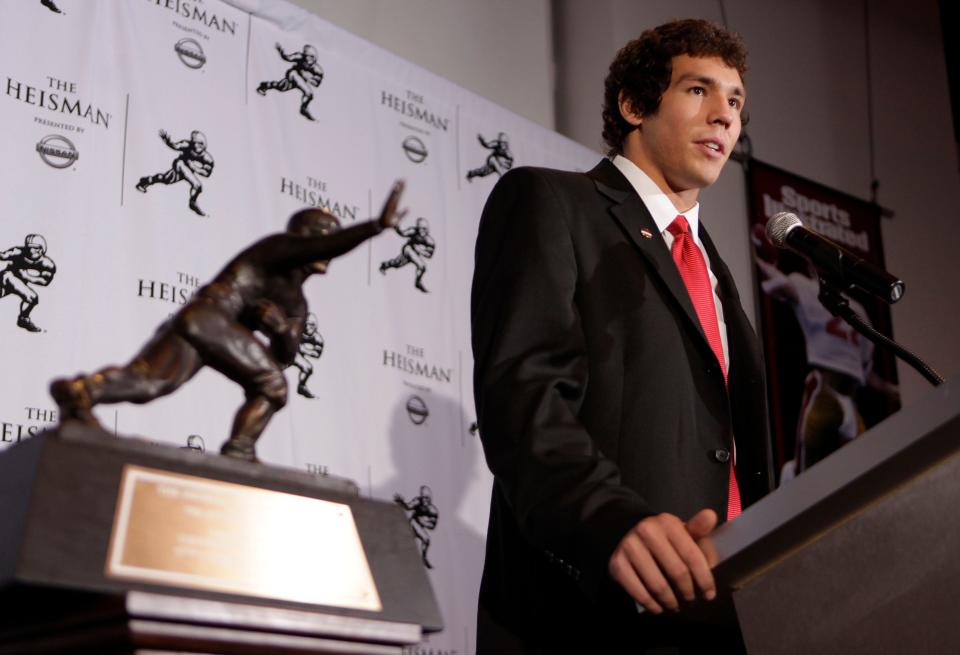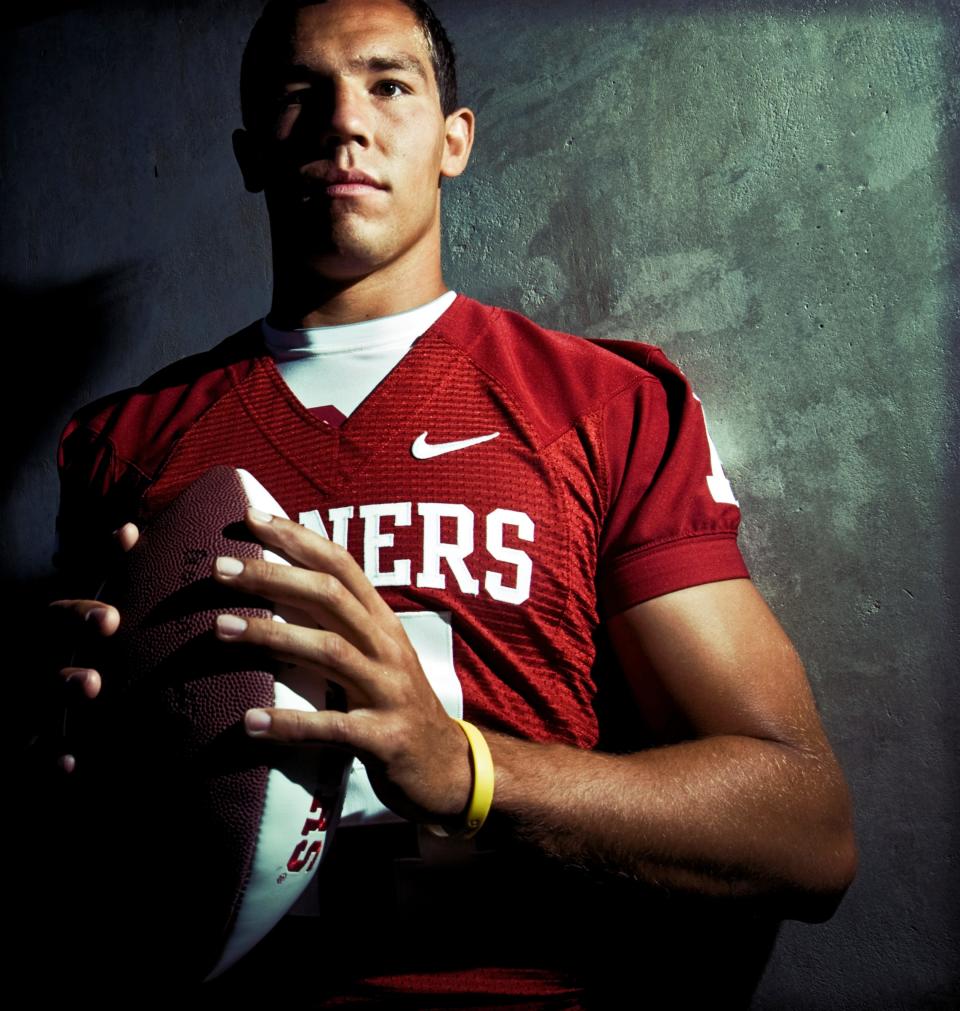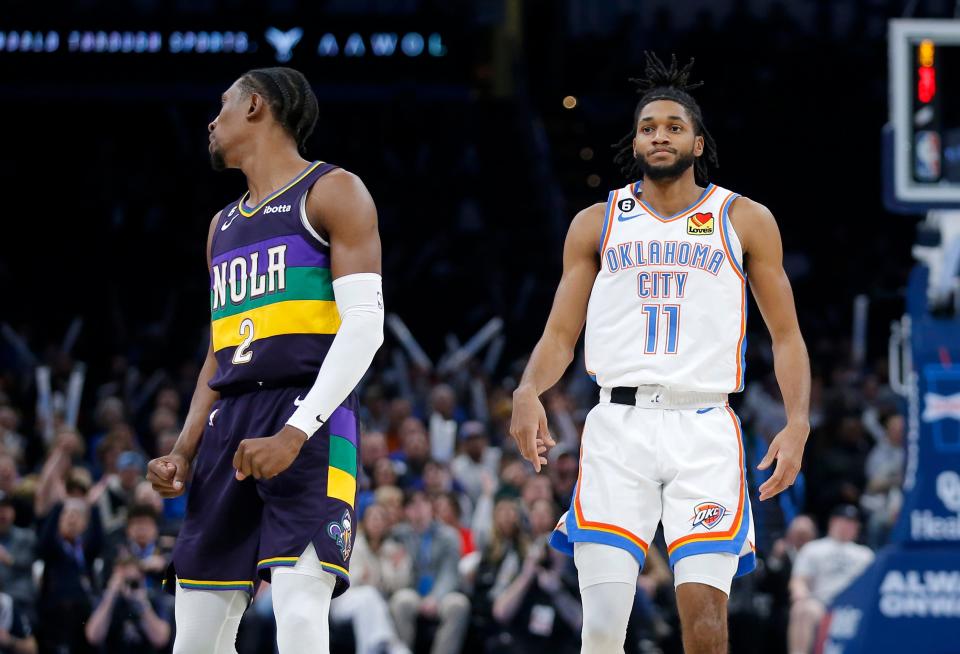Tramel's ScissorTales: Why an empty Owen Field was Sam Bradford's favorite football memory
Sam Bradford won a Heisman Trophy, won two Big 12 championships, was the overall No. 1 pick in the NFL Draft and quarterbacked in such venerable venues as Lambeau Field, Soldier Field and Candlestick Park.
But his favorite football memory came with empty stands and no crowds to cheer.
Bradford and Johnny Bench were inducted into the American Indian Athletic Hall of Fame last Friday at the First Americans Museum, and Bradford gave a 22-minute speech (can you believe it?) in which he recounted his journey.
And the best stories came from 2006, his redshirt season at OU, when Paul Thompson quarterbacked the Sooners and Bradford did not play.
"Not many people get to live out their dreams,” Bradford said. “I did.”
Bradford’s dad, Kent, was an offensive lineman on Barry Switzer’s 1970s teams, and Sam Bradford grew up going to Putnam City schools and watching the Sooners.
More: OU baseball rewind: Why this week is massive for Sooners' NCAA Tournament hopes

“All I ever wanted was to run through that tunnel as quarterback of the Sooners,” Bradford said.
Bradford was not a highly-recruited QB at Putnam North, though he was a multi-sport athlete.
Bob Stoops presented Bradford on Friday night for induction and called Bradford one of his “all-time favorites … I love the guy. He’s the best. He set the standard.”
Stoops now coaches the Arlington Renegades of the XFL and has Chuck Long, his former Iowa teammate and OU offensive coordinator, on the staff. Long last week reminded Stoops that Bradford’s acumen for golf drew their interest – four-hour games, mentally demanding, similar to quarterbacking. The staff liked his arm, his basketball competitiveness and decided to offer a scholarship.
“I think I waited all of 12 hours to accept,” Bradford said.
In 2006, Josh Heupel became OU’s quarterback coach, and Bradford still credits Heupel for all that followed.
“Coach Heupel taught me how to play quarterback,” Bradford said. “And he taught me how to work. It would be an understatement to say I was raw when I walked onto campus.
“I was a pretty good athlete, but Coach Heupel saw something in me. He helped me every step of the way during my time in Norman. I am grateful for what he saw in me.”

Bradford told a story. His birthday is November 8. That first year in Norman, Bradford looked longingly towards that birthday.
That redshirt year, Bradford’s days were structured: 5:45 a.m. workouts with strength coach Jerry Schmidt, class, practice, 45-minute workout with Heupel on quarterback mechanics, cafeteria, study hall.
But his parents were coming down from Oklahoma City to take him to dinner.
“The days were long and there wasn’t much time,” Bradford said. “My birthday offered a glimmer of hope. I was thrilled to escape the cafeteria and study hall for a night.”
Bradford had convinced himself he could skip the Heupel workout and go have a nice dinner with his parents.
“So practice ends, and I made it five steps,” Bradford said. Then he heard Heupel. “Where the bleep do you think you’re going?”
Bradford tried to explain.
“He said he didn’t give a blank what day it was, we were working that day.
“I never took another day off.”
That kind of dedication paid off for both. Bradford won a Heisman, and Heupel is the head coach at rejuvenated Tennessee.
More: Bob Stoops tops list of best OU coaching hires in Joe Castiglione's 25 years as Sooners AD
But that wasn’t Bradford’s favorite football memory.
That November, after the days shortened and the time changed, OU’s Monday night scrimmages moved into the stadium, played on Owen Field under the lights. The scrimmages were for all the players who weren’t taking the field on Saturdays.
Monday Night Football, they called it, and as the scrimmage moved into the stadium, “I was freaking out,” Bradford said.
That night, Bradford threw a couple of touchdown passes and was starting to realize that he might just make it as an OU quarterback.
After practice, Bradford didn’t want to take off his uniform.
“Went to the locker room and sat there for almost 30 minutes,” Bradford said. “I couldn’t believe it.”
A year later, Bradford was the OU quarterback. He beat Texas in the Cotton Bowl, won Bedlam and beat top-ranked Missouri in the Big 12 Championship Game at San Antonio.
“But I will never forget that first time under the lights,” Bradford said. “Coolest night of my life.”
More: Tramel's ScissorTales: Big 12 fares well in first round of NFL Draft, with six picks
Mailbag: SEC compromise
My readers always are thinking. Like this interesting idea about the Southeastern Conference’s dilemma of going with either an eight-game or a nine-game league schedule.
Jason: “Instead of a 1-7 or 3-6 model, what about a 2-7 and 2-6 model where the first year is nine games and the second year is eight games? That would allow for two permanent rivals and an opportunity for a marquee non-conference game (Bedlam or something similar) every other year. I’m just thinking outside the box.”
Tramel: I like outside the box. I much prefer the nine-game schedule, but let’s check out the every-other-year format.
With a 2-6/2-7 format, SEC members would have 13 other schools to sort through. Using a 2-6/2-7 format, you would play two permanent rivals and would see every other league member once every two years, including a home game for each, meaning at least one home game every four years.
So that works effectively the same as the 3-6 model, with just one fewer permanent rival. And it would offer the opportunity for better non-conference scheduling.
Maybe that’s a compromise the SEC needs, since the lower-rung football programs are slow to embrace a nine-game conference schedule. Split the baby in half.
But opportunity for better non-conference scheduling already exists. Schools just choose not to use it.
The nine-game format guarantees that more quality games will be played. I think the nine-game format will win out. But you never know.
The scheduling format is supposed to be decided May 30-June 1 at the SEC meetings in Destin, Florida. Here’s a compromise if there’s a stalemate in Destin.
More: Tramel's ScissorTales: Has Russell Westbrook found a longterm NBA home with the Clippers?

Thunder report card: Isaiah Joe
The Thunder’s signing of Isaiah Joe was a huge moment for the season. Joe turned into an indispensable member of the squad, with his shooting and scoring.
We continue our series on Thunder individual report cards, today with Joe.
Shooting: A. Joe played two seasons with the 76ers and made 35.5 percent of his 3-point shots. He made just 29.2 percent of his long 2-pointers with Philadelphia. Joe made just 34.2 percent of his college 3-point shots in his final season at Arkansas. There was little reason to believe he was on the verge of being a dead-eye shooter. But Joe was. He made 40.9 percent of his deep balls and gave the Thunder a huge lift in a long-standing franchise weakness.
Start: A. Joe was signed on October 16, three days before the season opener. He played in just four games, 7½ minutes total, with only one basket in the first 12 days. And on October 29 in Dallas, Joe didn’t even enter the game until 4:53 left in the fourth quarter and the Thunder trailing 95-79. But Joe scored seven points the rest of regulation, including a tying 3-pointer with 15 seconds left, then scored eight points in overtime to key a stunning, 117-111 upset. He had a spot in the rotation and was on his way.
Finish: D. Joe slumped down the stretch. His 3-point shooting fell from .452 before the all-star break to .348 after the all-star break, including an alarming .314 in 17 March games. In the two play-in games, Joe combined to make just four of 14 shots, including 2-of-8 from 3-point range, for a total of 10 points. Did defenses figure out something? Keep an eye on it.
Driving: B. Joe was more than just a spot-up shooter. As the season progressed, he showed more of an affinity for driving the ball and scoring. Joe made 70.6 percent of his shots from the restricted area, sixth-best on the team and ahead of the likes of basketball-assaulters Shai Gilgeous-Alexander and Josh Giddey. But only 6.7 percent of Joe’s shots were from that 0-3 feet area. More drives could give Joe some shooting space.
Ballhandling: B. Joe was remarkably careful with the ball. His turnover rate of 6.6 was third-best on the team, behind only Lindy Waters III and Mike Muscala. And Joe wasn’t a ball-stopper. He whipped the ball around when the Thunder was searching for a shot, and his 8.7 assist rate was solid for a 3-point specialist.
More: Tramel's ScissorTales: Bob Stoops makes playoffs in XFL reboot with Arlington Renegades
The List: Kentucky Derby names
The Kentucky Derby will be run Saturday in Louisville, and like always, my interest lies in the names of the beasts. Here is the 20-horse field, ranked in order of names, best to worst:
1. Confidence Game: Good name. Wouldn’t be No. 1 most years.
2. Forte: Personal bias – I've always liked the word “forte.”
3. Reincarnate: Not Whirlaway, but a cool one-word name, which usually are the best.
4. Rocket Can: Play on words
5. Kingsbarn: Interesting mix of words.
6. Raise Cain: Raising Cain would be even better.
7. Tapit Trice: No idea what it means, but it has a certain ring to it.
8. Veryifying: Veryify would be even better.
9. Hit Show: At least catches your ear.
10. Angel of Empire: Angel is a good word, empire is a good word, but prepositions are a bummer.
11. Lord Miles: At least sounds regal.
12. Jace’s Road: At least sounds rural.
13. Mage: No idea.
14. Practical Move: Not a practical name.
15. Sun Thunder: Maybe it needs a preposition.
16. Disarm: I don’t know why it’s a turnoff, but it is.
17. Skinner: Sounds like a golfing buddy.
18. Two Phil’s: Sorry, I can’t go along with the punctuation crime.
19. Derma Sotogake: Someone spilled the Scrabble tiles.
20. Continuar: I don’t even know how to pronounce it.
Berry Tramel: Berry can be reached at 405-760-8080 or at btramel@oklahoman.com. He can be heard Monday through Friday from 4:40-5:20 p.m. on The Sports Animal radio network, including FM-98.1. Support his work and that of other Oklahoman journalists by purchasing a digital subscription today.
This article originally appeared on Oklahoman: OU football: Sam Bradford's favorite memory was a 2006 scrimmage

